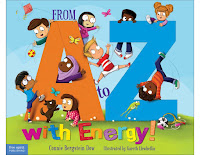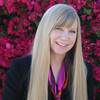This past month, I have enjoyed visiting children in preschool, kindergarten, first, and second grades, in three different school systems around Ohio. This is probably the most fun part of being an author and dance educator. I have the opportunity to share my picture book with young children, librarians, and teachers, and I also have the chance to share my love of movement.
 |
| Reading to a kindergarten class |
I wrote From A to Z with Energy! to inspire children to be healthy and active. The book's unofficial subtitle, "26 Ways to Move and Play," is a good description of what I do while visiting with young children in their classrooms.
After I have read my book aloud, I spend the rest of the time tying movement to early literacy concepts. We dance about the letters in the alphabet. We might start out by thinking of action words that begin with different letters. For example, the letter S is the first letter in the words Sit, Stand, Stretch, Squiggle, Stomp, Shake, Soar, and making Silly Shapes. I ask the children to first make the shape of an S in their bodies. Then we try out the many action words that start with that letter. We have the whole array of letters to choose from, and we move in many different ways as we dance through the alphabet.
Another early literacy concept is recognizing rhyming words. My book is a rhyming story, so I make sure to ask the children to listen for rhyming words as I read the story. Then we play a game in which I create pairs of rhyming words, with one of the words being a movement. I might ask them, what action word rhymes with "ounce?" "Bounce!" Then we all do some bouncing movements together. Other examples of rhyming pairs are bake-shake, pop-hop, arch-march, fun-run, and pants-dance.
 |
| "March" rhymes with "Arch!" |
All of the above activities can be done in a large gym with the children moving away from and back to a home spot. But if you only have a small space, don't worry! Children can get an active workout even staying in one spot. They can sit and stand, go up on tiptoe, stretch, squiggle, stomp, shake, balance, make silly shapes, run in place, march, turn, hop, jump, twist, and dance, all in one spot.
Another fun movement game is to practice the concept of opposites. This is a vocabulary exercise as well. A child might not be able to describe the meaning of the word "opposite," but he or she can learn and experience opposites kinesthetically. Some of the movement opposites we explore are:
Happy/Sad, Straight/Twisty, Hot/Cold, Quiet/Loud, Tired/Energetic, Slow/Fast, Right/Left, Heavy/Light, Facing Forward/Facing Backward, Up/Down. All of the above movements can be performed moving through a large space, or staying in a home spot.
I would love to visit your school or library! For more information, please visit the School Visit Info page
of my website www.movingislearning.com.
Keep on Dancin'!
Connie
 |
| MOVING IS LEARNING! |







